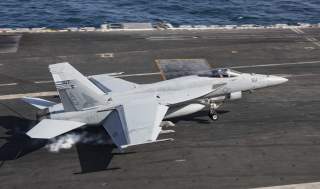Think America Could Invade Venezuela? We Have No Aircraft Carriers Available.
And that would be a problem.
The United States’ legacy in Latin America is much older than Trump and Graham are. It’s a legacy that weighs heavily on the Pentagon’s reluctance to sail major warships through Latin American waters.
A failed coup attempt targeting Venezuelan president Nicolas Maduro on April 30 ended in confusion and failure. Russian and Cuban advisors and a strong core of the Venezuelan military continues to support Maduro amid economic collapse and widespread protests.
(This first appeared several weeks ago.)
U.S. president Donald Trump in 2018 threatened military action against Maduro but didn’t make good on the threat. Washington instead imposed sanctions in order to pressure Maduro to step down.
But at least one lawmaker wants to escalate Washington’s involvement in the Venezuelan tragedy. “Cuba, Russia send troops to prop Maduro up in Venezuela … while we talk/sanction,” Sen. Lindsey Graham, a South Carolina Republican, on May 3, 2019 tweeted. “Where is our aircraft carrier?”
It’s true that U.S. Southern Command permanently controls none of the U.S. Navy’s 11 aircraft carrier and few other major forces. But there’s a good reason for that. U.S. Central Intelligence Agency in 1973 backed Chilean general Augusto Pinochet in his military coup against the socialist government of Salvador Allende.
Pinochet’s brutal, 17-year rule marked an inflection point in U.S. relations with Latin America. “It was one of the more notorious of many interventions by the United States in Latin America,” The Economist in 2018 explained, “starting with a war against Mexico in 1846, including other coups during the Cold War and culminating in the invasion of Panama in 1989 to topple Manuel Noriega, a former American intelligence asset turned ally of drug traffickers.”
This legacy forged enduring and widespread resentment. It has made non-intervention in the affairs of other states Latin governments’ default diplomatic position, attenuated only timidly by the adoption of the defence of human rights and democracy in the Inter-American Democratic Charter of 2001.
This history explains why the region expressed alarm when Donald Trump mused a year ago [in 2017] about military action to overthrow the dictatorial government of Nicolás Maduro in Venezuela. The main Latin American governments refused to recognise a fraudulent election in May [2018] in which Mr. Maduro re-elected himself. But they argue that yanqui threats merely strengthen him. They trust in diplomatic pressure and opposition within the country to restore democracy.
History explains why the Florida-based Southern Command is the smallest and least heavily-armed of the Pentagon’s 10 unified commands. SOUTHCOM’s permanent forces number just 1,200 civilians and uniformed personnel.
At any given time on average, a few thousand U.S. troops and a handful of warships are on deployment in the SOUTHCOM area of operation. U.S. Indo-Pacific Command, by contrast, at any given time oversees scores of warships, hundreds of warplanes and more than 100,000 personnel.
Despite Trump’s bluster and Graham’s clamoring for a major naval deployment, SOUTHCOM commander Navy admiral Craig Faller on May 1, 2019 told a U.S. House of Representatives committee that his command operates not on force, but on trust.
“The men and women of our team work every day to earn the trust of partners in Latin America and the Caribbean,” Faller said. “We are friends and neighbors, bound together by shared values and a shared stake in our common future.”
“The majority of nations in this hemisphere share democratic values—including respect for human rights and adherence to the rule of law—and interests in advancing democracy and countering radical ideologies,” Faller continued.
“These shared values and interests are the foundation of our military-to-military relationships. We reinforce and build on these shared values and interests through institutional capacity building efforts, information and intelligence sharing, education, personnel exchanges and exercises.”
Leaving aside the fact that America’s navy already arguably is over-stretched and its aircraft carriers, in particular, are busy deterring Russia and China, and that deploying a flattop might not do anything to help the hungry, desperate people of Venezuela, there are good reasons SOUTHCOM doesn’t have a carrier on hand.
The United States’ legacy in Latin America is much older than Trump and Graham are. It’s a legacy that weighs heavily on the Pentagon’s reluctance to sail major warships through Latin American waters.
David Axe serves as Defense Editor of the National Interest. He is the author of the graphic novels War Fix, War Is Boring and Machete Squad.

